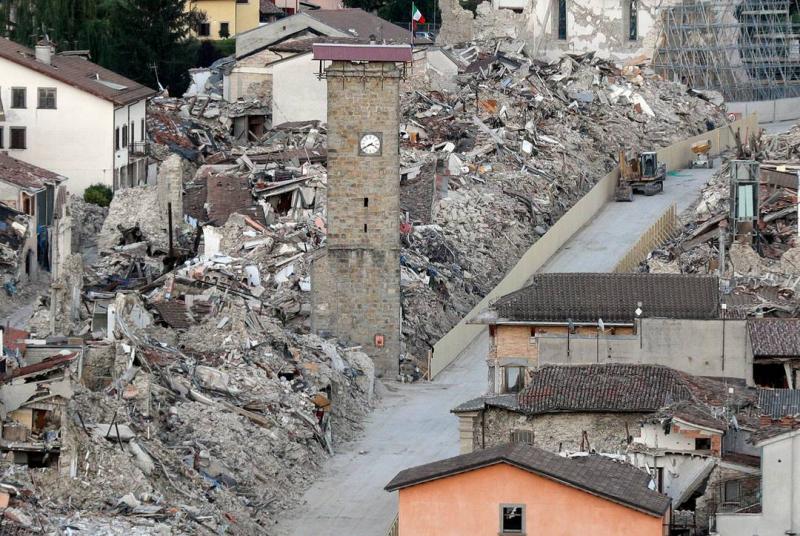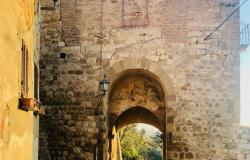Amatrice, A Year After the Earthquake
ITA:

Use player to listen to Italian version
A year after a powerful earthquake rattled central Italy (August 24, 2016), one of the hardest hit villages, Amatrice, is still full of rubble. The removal of debris is in fact far from being completed; and while the Historical Archive of Amatrice has been salvaged, the village’s three most important monuments, the Basilica of San Francesco, which suffered enormous damage to its 14th century façade, the Church of Sant’Agostino, partly collapsed, and the 13th century Civic Tower, haven’t been either reconstructed or fully secured yet.
The damage this village in Lazio has suffered is made all the more painful when you consider that Amatrice is listed as one of Italy’s most beautiful historic villages; yet, to this day, it remains indelibly scarred.
The splendid façade of the Church of San Francesco, which dates to the 14th century, was fractured during the earthquake and lost its oculus. The roof and the upper half of the façade, including the rose window, of the Church of Sant’Agostino, which was completed in 1428, collapsed. The 13th century Civic Tower, one of the symbols of Amatrice, withstood the earthquake, but it has yet to be made quake proof.
Amatrice was built at the foot of the Monti della Laga mountains in the Middle Ages. There are different theories about the origins of its name, but everybody agrees that it has to do with the concept of ‘Mother.’ For some, Amatrice is the ‘Mother of Tronto’, Mater Truentum, referring to the source of the river Tronto which is found in the mountains near Amatrice; for others, it refers to the concept of ‘Mother Church’, common in the Middle Ages, from which Matrice, a name first mentioned in 1012, and then Amatrice, derive.
A popular tourist destination before the earthquake, Amatrice is the town that gave the name to one of Lazio’s, and Italy’s, most famous dishes: bucatini all’amatriciana, made with guanciale and pecorino cheese.
100 million euros have been allocated by the Italian government to help the struggling economy of southern Italy. Part of it is supposed to be used for the reconstruction of the villages damaged by the earthquake, including Amatrice, to bring their historic centers as close as possible to their original state. If the money is used for this purpose remains to be seen.
Un anno dopo il potente terremoto che ha scosso l'Italia centrale, avvenuto il 24 agosto 2016, uno dei villaggi più colpiti, Amatrice, è ancora pieno di macerie. La rimozione dei detriti è infatti lungi dall'essere completata; e, mentre l'Archivio Storico di Amatrice è stato salvato, i tre monumenti più importanti del paese, la Basilica di San Francesco, che ha subito enormi danni alla facciata del XIV° secolo, la Chiesa di Sant'Agostino, in parte crollata, e la Torre Civica del XIII° secolo, non sono stati ancora ricostruiti o messi in sicurezza.
I danni subiti da questo villaggio del Lazio sono resi ancora più dolorosi dal fatto che Amatrice è elencata come uno dei borghi storici più belli d'Italia; eppure, fino ad oggi, rimane indelebilmente segnata.
La splendida facciata della chiesa di San Francesco, risalente al XIV° secolo, è stata spezzata durante il terremoto e ha perso l’oculo. Il tetto e la metà superiore della facciata, compreso il rosone, della chiesa di Sant'Agostino, completata nel 1428, sono crollati. La Torre Civica del XIII° secolo, uno dei simboli di Amatrice, ha resistito al terremoto, ma deve ancora essere resa antisismica.
Amatrice fu costruita ai piedi dei Monti della Laga nel Medioevo. Ci sono diverse teorie sulle origini del suo nome, ma tutti concordano sul fatto che abbia a che fare con il concetto di "Madre". Per alcuni, Amatrice è la "Madre di Tronto", Mater Truentum, riferendosi alla sorgente del fiume Tronto che si trova nelle montagne vicino ad Amatrice; per altri, si riferisce al concetto di "Chiesa Madre", comune nel Medioevo, da cui derivano Matrice, un nome citato per la prima volta nel 1012, e poi Amatrice.
Frequentata destinazione turistica prima del terremoto, Amatrice è la città che ha dato il nome a uno dei piatti più famosi del Lazio e d’Italia, i bucatini all'amatriciana, fatti con guanciale e pecorino.
Il governo italiano ha stanziato 100 milioni di euro in aiuti per l’economia in difficoltà dell'Italia meridionale. Una parte dei fondi dovrebbe essere utilizzata per la ricostruzione dei villaggi danneggiati dal terremoto, tra cui Amatrice, per riportare i loro centri storici il più vicino possibile allo stato originale. Se i soldi saranno utilizzati a questo scopo, resta da vedere.











